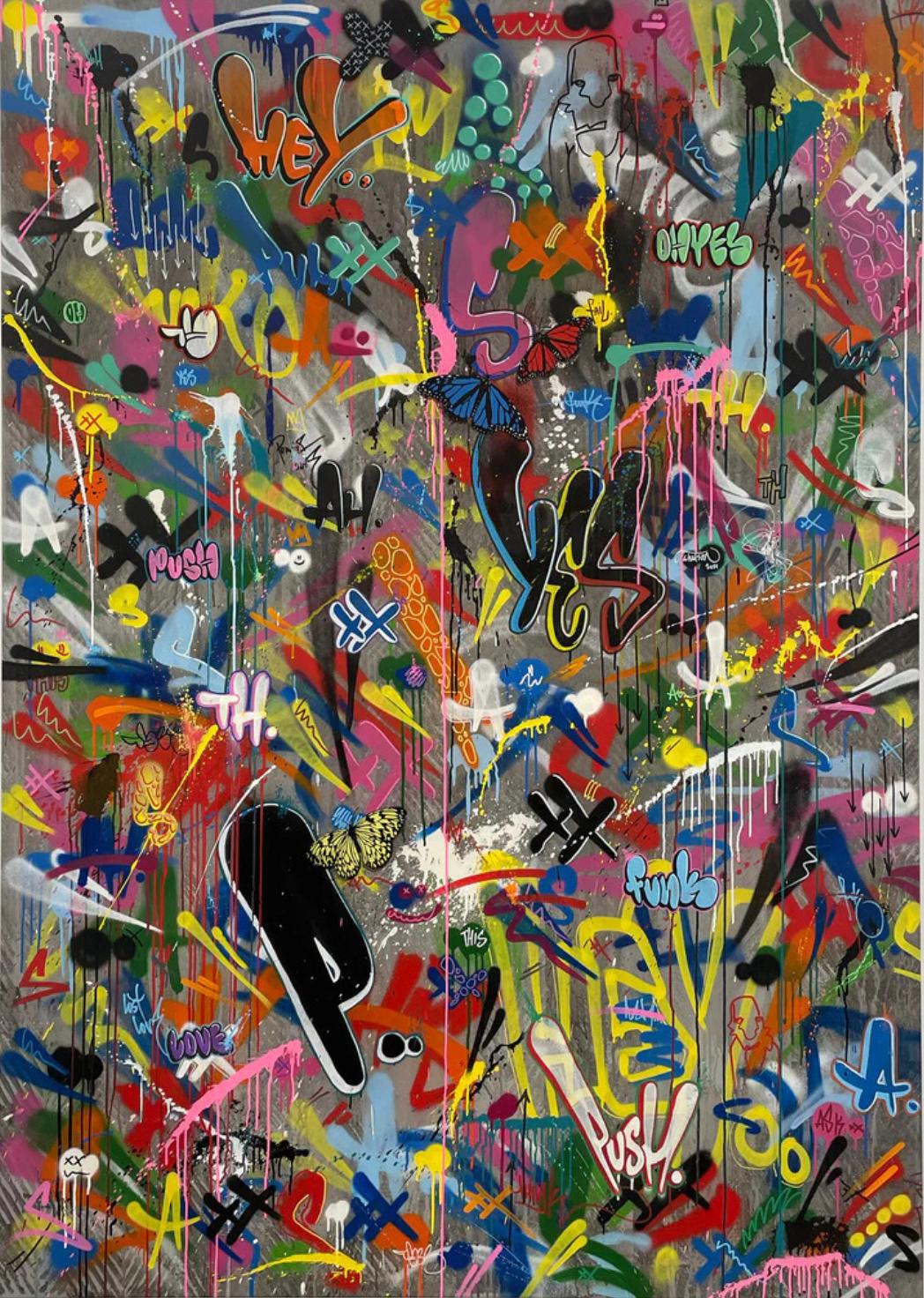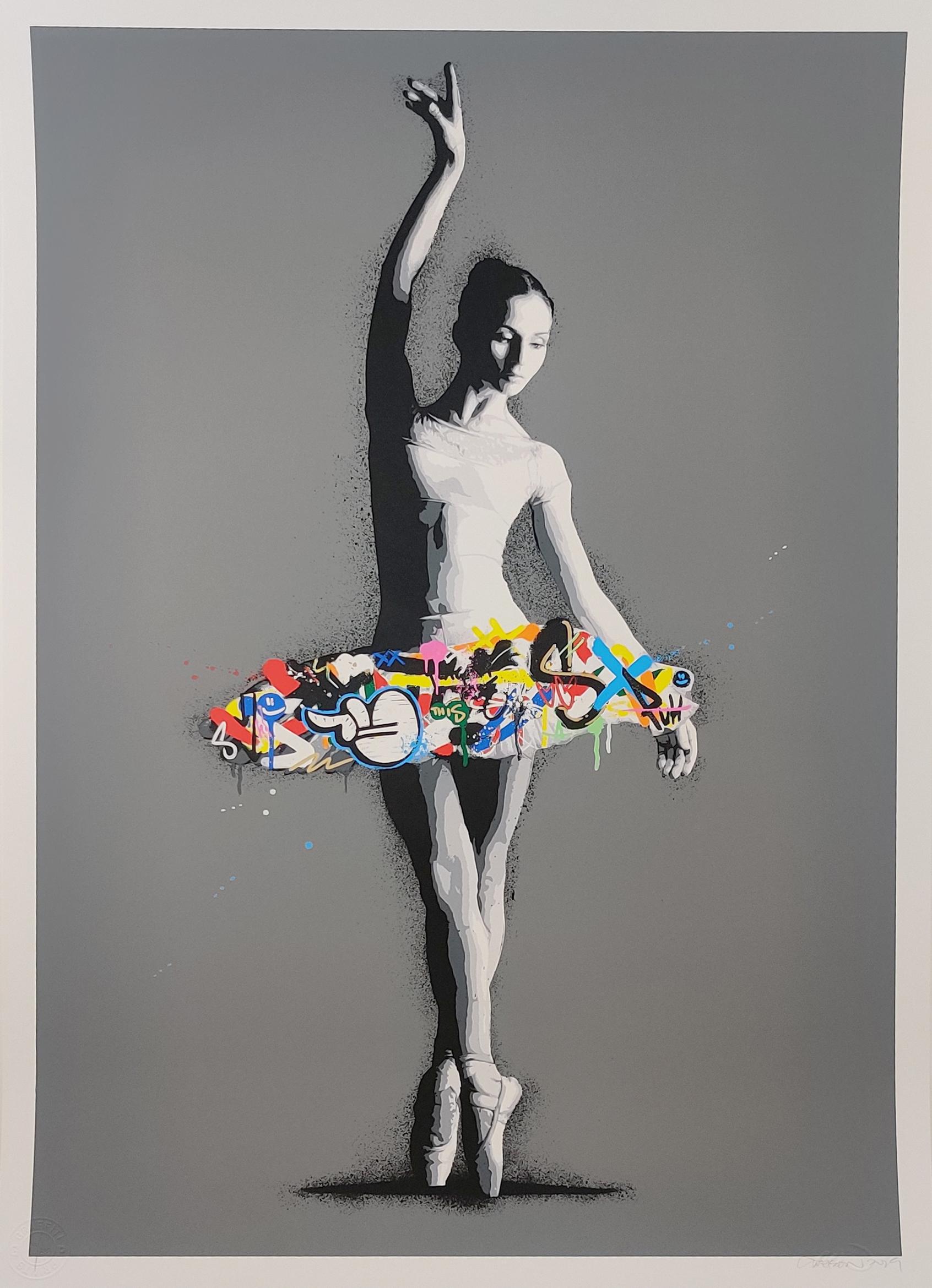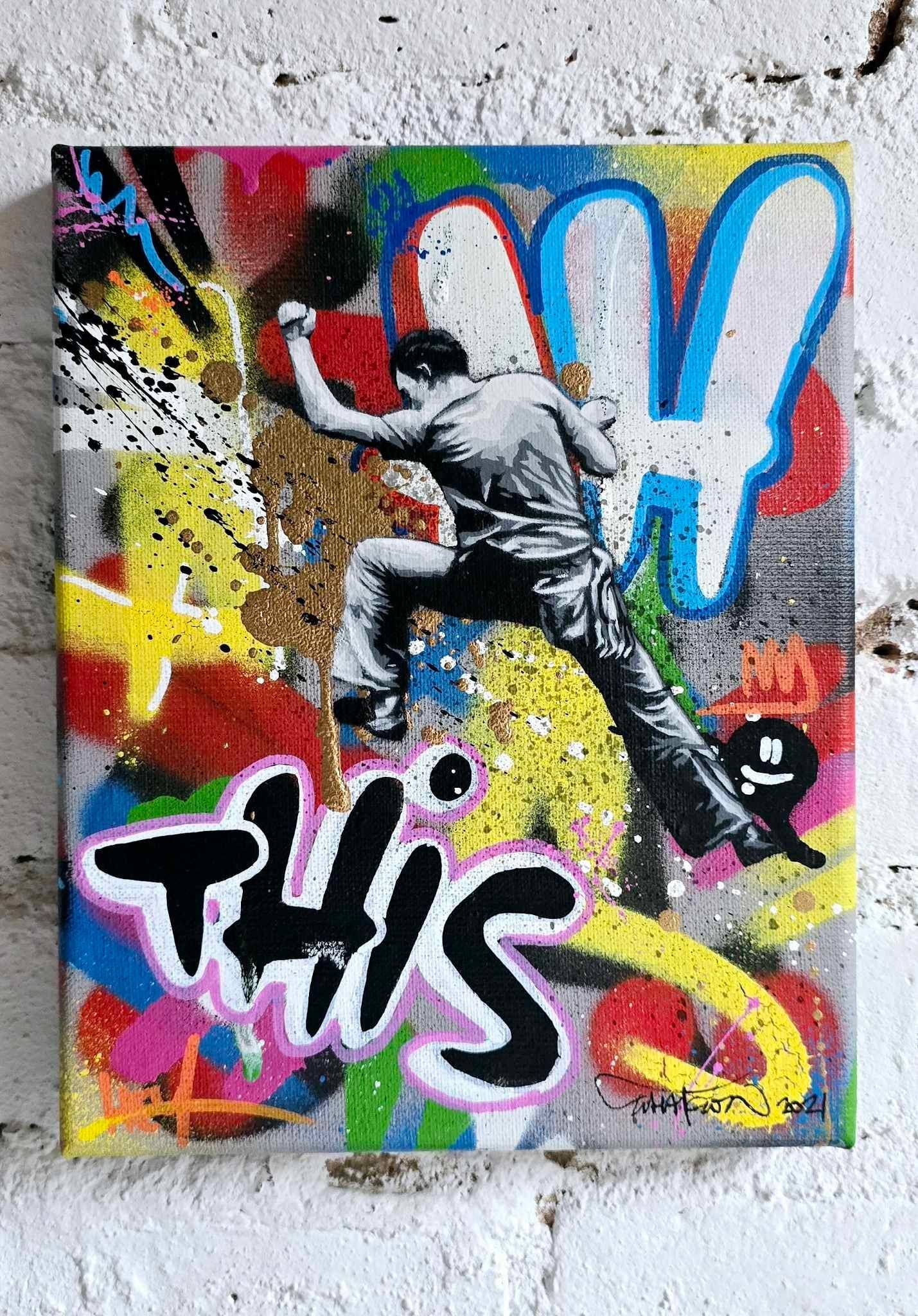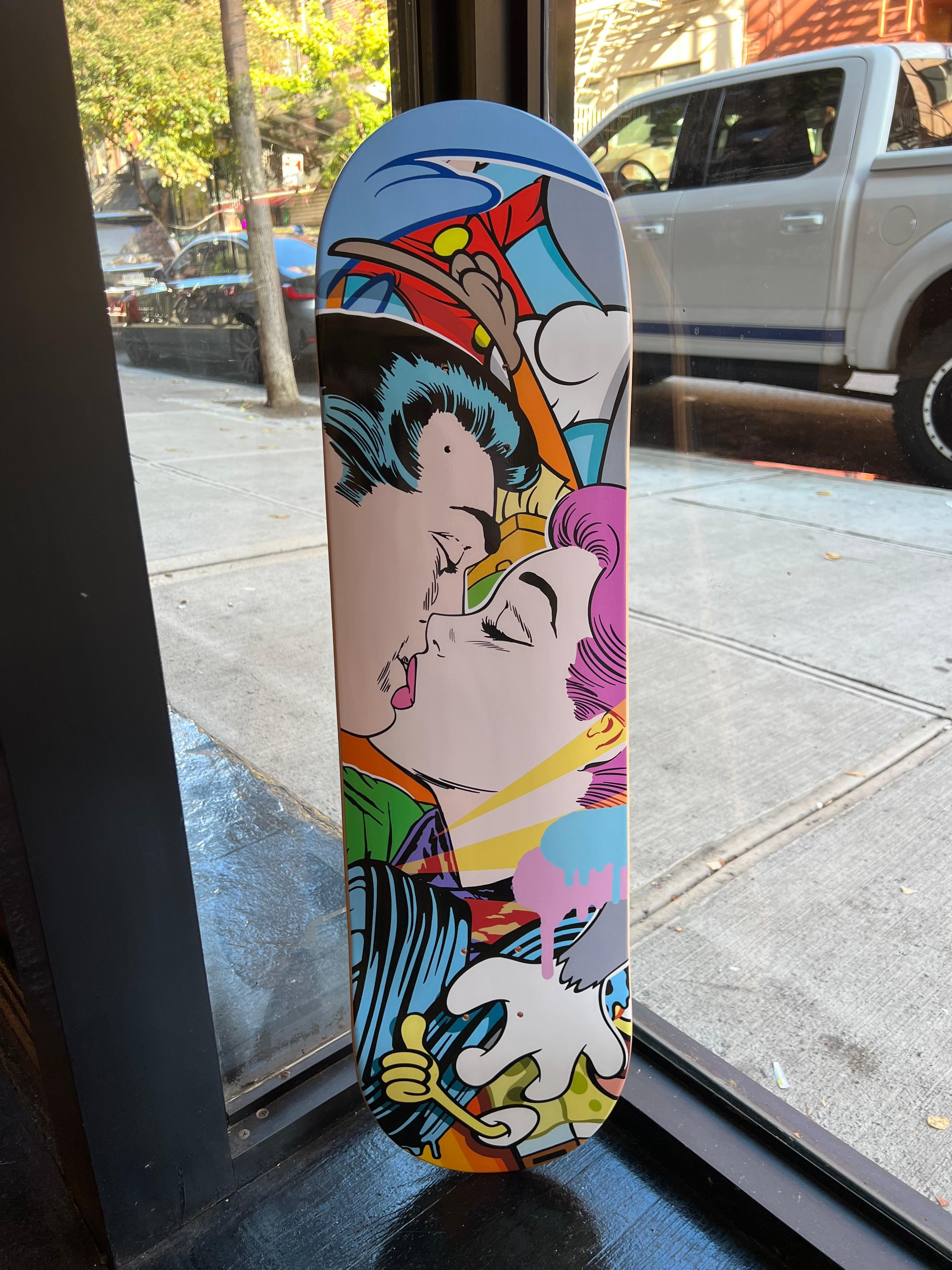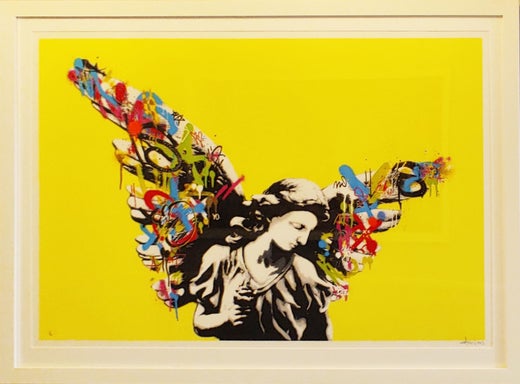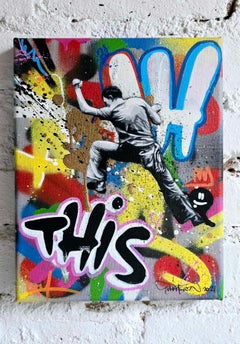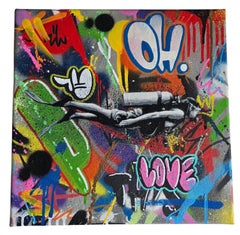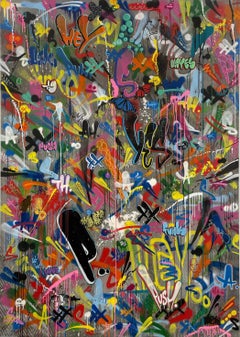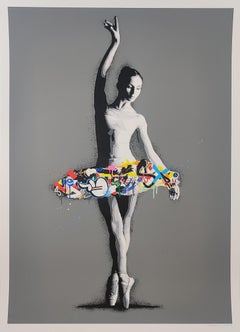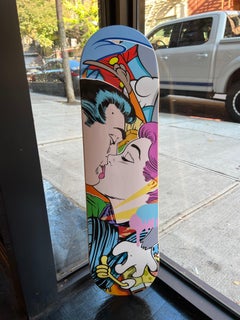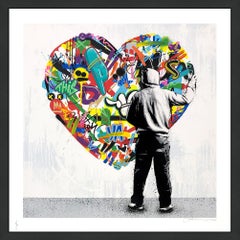Items Similar to Original Skatedeck by Martin Whatson
Want more images or videos?
Request additional images or videos from the seller
1 of 3
Martin WhatsonOriginal Skatedeck by Martin Whatson2021
2021
$5,440
$6,80020% Off
£4,218.87
£5,273.5920% Off
€4,799.56
€5,999.4520% Off
CA$7,783.88
CA$9,729.8620% Off
A$8,504.54
A$10,630.6820% Off
CHF 4,472.89
CHF 5,591.1220% Off
MX$102,246
MX$127,807.4920% Off
NOK 56,317.37
NOK 70,396.7120% Off
SEK 52,874.56
SEK 66,093.2020% Off
DKK 35,839.21
DKK 44,799.0120% Off
About the Item
Original Hand-Painted Skatedeck
Artist: Martin Whatson
78 x 20 cm
Year: 2021
- Creator:Martin Whatson (1984, Norwegian)
- Creation Year:2021
- Dimensions:Height: 30.71 in (78 cm)Width: 7.88 in (20 cm)
- Medium:
- Movement & Style:
- Period:
- Condition:
- Gallery Location:New York, NY
- Reference Number:1stDibs: LU1716215235972
Martin Whatson
Martin Whatson is a Norwegian stencil artist based in Oslo with his debut in 2004. Whatson was inspired by artists like Jose Parlá and Cy Twombly. Whatson's abstract graffiti and stencils are a mix of urban scenes showing the development of a wall’s lifetime. Whatson has had several solo shows across the world in venues such as Tokyo, Paris, London, New York and Los Angeles.
About the Seller
5.0
Vetted Professional Seller
Every seller passes strict standards for authenticity and reliability
Established in 2018
1stDibs seller since 2022
48 sales on 1stDibs
Typical response time: 2 hours
- ShippingRetrieving quote...Shipping from: New York, NY
- Return Policy
Authenticity Guarantee
In the unlikely event there’s an issue with an item’s authenticity, contact us within 1 year for a full refund. DetailsMoney-Back Guarantee
If your item is not as described, is damaged in transit, or does not arrive, contact us within 7 days for a full refund. Details24-Hour Cancellation
You have a 24-hour grace period in which to reconsider your purchase, with no questions asked.Vetted Professional Sellers
Our world-class sellers must adhere to strict standards for service and quality, maintaining the integrity of our listings.Price-Match Guarantee
If you find that a seller listed the same item for a lower price elsewhere, we’ll match it.Trusted Global Delivery
Our best-in-class carrier network provides specialized shipping options worldwide, including custom delivery.More From This Seller
View AllSurfer Original by Martin Whatson
By Martin Whatson
Located in New York, NY
Martin Whatson
Surfer Canvas
Original Painting on Canvas
Framed professionally in a black tray frame
Signed on reverse by Martin Whatson
39.3 x 27.5 inches
42 x 30 with frame
...
Category
2010s Street Art Animal Paintings
Materials
Spray Paint, Stencil
Paint Love by Martin Whatson
By Martin Whatson
Located in New York, NY
Martin Whatson
"Paint Love"
Limited Edition out of 150
24 Layer Screenprint
Signed and Numbered by the artist
Category
2010s Street Art Prints and Multiples
Materials
Screen
$2,560 Sale Price
20% Off
Climber Canvas by Martin Whatson
By Martin Whatson
Located in New York, NY
Martin Whatson
Mini Climber Canvas
Original Painting on Canvas
25 x 20 cm
Mixed media on canvas
Edition:
1 of 1
2021
Category
2010s Street Art Animal Paintings
Materials
Spray Paint, Stencil
$3,850 Sale Price
30% Off
Scuba Diver Canvas by Martin Whatson
By Martin Whatson
Located in New York, NY
Martin Whatson
Scuba Diver Mini Canvas
30 x 30 cm
Edition of 3
Mixed Media on Canvas
COA Included
Category
2010s Contemporary Mixed Media
Materials
Spray Paint
Martin Whatson Cracked Screenprint 2022
By Martin Whatson
Located in New York, NY
30 Colour Screen Print On 300 Somerset paper with embossed heart
Edition of 250
Signed By The Artist
100 x 70 cm
2022
Comes with Certificate Of Authenticity
Category
2010s Street Art Prints and Multiples
Materials
Screen
Pop Glitch by Jay Kaes Skatedeck
Located in New York, NY
Technique: Original Giclée Fine Art Print by Jay Kaes. Archival Pigment Print on Skateboard Deck
Year: 2023
Size: 85 x 22 cm
Edition: 15 - ONLY 2 left in Edition
Collection: Dopa...
Category
2010s Street Art Prints and Multiples
Materials
Giclée
You May Also Like
Urban Camoflauge
By Martin Whatson
Located in Hollywood, FL
Artist: Martin Whatson
Title: Urban Camouflage
Size: 81.5 x 58 Inches
Medium: Mixed Media on Canvas
Edition: Original
Year: 2021
Notes: Hand Signed, Dated, Titled, and Num...
Category
2010s Street Art Mixed Media
Materials
Canvas
Passe, Martin Whatson, Limited Edition Street Art Print
By Martin Whatson
Located in Draper, UT
Passe, 2019
Martin Whatson
21 color screen print on 300 gsm Somerset
31 1/2 × 22 in
80 × 56 cm
Limited dition of 295
Category
2010s Street Art Prints and Multiples
Materials
Paper
$4,720 Sale Price
20% Off
street art artist Bustart "Skate Pop Love" Pop Art print on skatedeck
By Bustart
Located in New York, NY
Skatedeck print
In 1999 BustArt began his artistic career with classic Graffiti. Until 2005, he became familiar with the whole spectrum of Graffiti and reached a new level of identi...
Category
2010s Street Art Figurative Prints
Materials
Acrylic, Wood Panel
Paint Love (Unique Hand Finished Screen Print)
By Martin Whatson
Located in Aventura, FL
Unique hand finished in spray paint and pens, 25 color screen print on 300gsm somerset paper. Hand signed and dated lower right by Martin Whatson. Hand numbered lower left. From t...
Category
2010s Street Art Figurative Prints
Materials
Paper, Screen, Spray Paint, Pen
$4,462 Sale Price
25% Off
JEAN-MICHEL BASQUIAT - In Italian. Skate Decks Pop Urban Art Design
By Jean-Michel Basquiat
Located in Madrid, Madrid
Jean-Michel Basquiat - In Italian
Date of creation: 2024
Medium: Digital print on Canadian maple wood
Edition: Open
Size: 80 x 20 cm (each skate)
Condition: In mint conditions and never displayed
This triptych is formed by three skate decks made of 7 ply grade A Canadian maple wood.
© Estate of Jean-Michel Basquiat. Licensed by Artestar, New York
In Italian (1983) is one of Jean-Michel Basquiat’s iconic works, created during a peak period of his artistic career. The piece reflects his distinctive style, blending graffiti, expressive brushwork, text, and symbolism. Like many of his paintings, "In Italian" presents a powerful and chaotic composition where words, figures, and signs interact in a raw and energetic visual language.
The title, In Italian, may suggest a reference to classical European culture—especially Italian Renaissance art—while at the same time subverting it through Basquiat’s urban, Afro-Caribbean perspective. His interest in contrasting high and low culture, refined and raw, is evident in this piece. The inclusion of text, often fragmented or cryptic, was one of Basquiat’s trademarks and serves here to provoke thought rather than deliver a clear message.
In this work, Basquiat explores themes such as identity, language, cultural heritage, and the appropriation of symbols. The figure depicted—alongside the textual elements—appears almost mythological or totemic, reinforcing Basquiat’s tendency to elevate marginalized characters into powerful, almost divine figures.
The brushstrokes are urgent, the colors bold, and the composition layered. It’s as if the viewer is meant to decipher a code—a mix of history, race, rebellion, and irony. Words in different languages, especially English and Italian, appear not to clarify meaning but to complicate it, suggesting the multilingual, multicultural environment Basquiat inhabited and commented on.
In Italian is a prime example of how Basquiat merged influences from the streets of New York with art history, African-American identity, and global culture. It's a bold visual statement that challenges traditional canons and forces the viewer to reconsider what art is, who gets to create it, and which voices are heard.
ABOUT THE ARTIST
Jean-Michel Basquiat (1960-1988) was one of the most influential artists of the 20th century, famous for his ability to fuse urban culture, social criticism and art history into a unique style. Born in Brooklyn, New York, to a Haitian father and Puerto Rican mother, his life and work were shaped by his multicultural heritage, the New York art scene and the social tensions of his time. Although his career was brief, his impact on contemporary art has been lasting and significant.
Basquiat showed an interest in art from an early age. His mother, Matilde Andrades, took him to museums and encouraged him to draw. At the age of seven, a car accident left him hospitalized for a time, and it was then that his mother gave him a copy of the anatomy book Gray's Anatomy, which influenced his fascination with the human body and its visual representation.
Despite his early talent, Basquiat's family life was turbulent. His mother was hospitalized for psychiatric problems and his relationship with his father, Gerard Basquiat, was troubled. This instability contributed to Basquiat dropping out of school at age 17 to pursue his artistic career on the streets of New York.
As a teenager, Basquiat joined the New York graffiti scene under the pseudonym SAMO (an acronym for "Same Old Shit"), which he used to sign his cryptic and poetic messages on the streets of Manhattan with his friend Al Diaz. SAMO's graffiti were a mixture of philosophical and social commentary on popular culture, capitalism and religion, and soon attracted the attention of the underground art scene.
In 1980, SAMO "died" when Basquiat and Diaz decided to end their collaboration, marking the beginning of Basquiat's transition from street graffiti to art galleries.
Basquiat emerged as a talent to watch in 1980, when he participated in the group exhibition The Times Square Show, which included other emerging artists from New York's Lower East Side scene. That same year, he attracted the attention of critics and collectors who saw in his work an electrifying blend of street art and neo-expressionism, the predominant movement of the time.
In 1981, art critic René Ricard published the influential essay The Radiant Child in Artforum magazine, which positioned Basquiat as one of the most promising artists of his generation. Shortly thereafter, he met renowned artist Andy Warhol, with whom he formed a close friendship and significant artistic collaboration. This association was instrumental in catapulting his career into the world of high art.
The collaboration with Warhol was a pivotal point in Basquiat's career. The two artists, although coming from very different worlds, shared a fascination with fame and popular culture. Together, they produced a series of works that combined Warhol's pop art icons with Basquiat's raw, spontaneous style.
However, this collaboration was also a source of controversy. Many critics accused Warhol of "exploiting" Basquiat, while others saw the collaboration as a creative dialogue between two genius minds. Although the criticism was mixed, there is no doubt that the relationship between the two artists helped cement Basquiat's reputation in the art world.
Basquiat's style is a unique amalgam of influences. His work is characterized by the use of dismembered human figures, skeletons and internal organs, evoking the fragility of the body and mortality. Basquiat also used symbols that alluded to African-American and African history, such as crowns, masks and references to historical figures such as Toussaint Louverture.
The use of text is another crucial aspect of his work. Words, phrases and numbers appeared in his paintings, often crossed out or overlapped, creating a sense of controlled chaos. These fragmented words provoked a non-linear reading of his works and conveyed multiple layers of meaning.
His art also reflected his concerns about racial issues, especially the place of people of African descent in Western art history and in society at large. The crowns that Basquiat often drew on his figures were a symbol of power and resistance, a way of proclaiming himself "king" in a world that had historically excluded black artists from the upper echelons of art.
In works such as The Death of Michael Stewart...
Category
2010s Pop Art More Art
Materials
Wood, Digital
Damien Hirst Supreme Skateboard Deck
By Damien Hirst
Located in NEW YORK, NY
Damien Hirst Spin Series Skate Deck, Supreme 2009
Medium: Screen print in colors on polychrome wood skateboard deck.
Excellent overal condition.
Dimensions: 31.1 x 7.68 in (78.99 x 19.51 cm).
Stamped signature and Supreme logo on reverse.
"Hirst first experimented with spin art in 1992 at his studio in Brixton (‘Beautiful Ray of Sunshine on a Rainy Day Painting and Beautiful Where Did All The Colour Go Painting’ (1992). The following year, he set up a spin art stall with fellow artist Angus Fairhurst at Joshua Compston’s artist led street fair, ‘A Féte Worse than Death’. Made up as clowns by performance artist Leigh Bowery, Fairhurst and Hirst invited visitors to pay £1 to create their own spin paintings to be signed by the pair, (and another £1 to drop their trousers and reveal their painted cocks and bollocks!)
The spin paintings are characterised by the works’ elongated titles, which begin with ‘Beautiful’ and end in ‘painting’, and their bright colours. The series began in earnest in 1994, when Hirst had a spin machine made whilst living in Berlin. A series of his machine-made spin drawings were subsequently exhibited at Bruno Brunnet Contemporary Fine Arts, Berlin, later that year. The exhibition ‘making beautiful drawings: an installation’, invited visitors to the gallery to make their own free drawings on a spin drawing machine made from a drill. The first Berlin-made spin painting exhibited was ‘Beautiful, pop, spinning ice creamy, whirling expanding painting’ (1995), at the Waddington Gallery, London, in 1995." (source: Damien Hirst site)
Related Categories:
Damien Hirst spin. Damien Hirst abstract. Damien Hirst skateboard...
Category
1990s Pop Art Prints and Multiples
Materials
Wood, Screen
Price Upon Request
